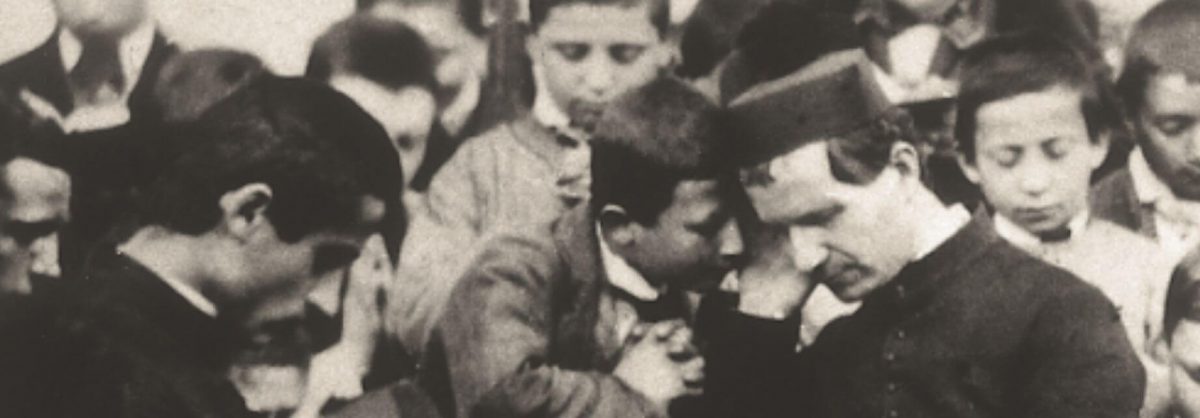Among the saints, few have a following like Saint John Bosco, or “Don Bosco,” as he is affectionately called. John is the patron of youth—especially of boys—and his impressive witness is needed in our Church today more than ever.
A native of Piedmont, Italy, John was raised by a single mother who was poor in worldly goods but rich in practical peasant-wisdom. From a young age, John studied card tricks and circus feats, and became good enough to offer shows for the neighborhood boys in his mother’s front yard. Entertaining though he was, John’s passion was winning souls, and the shows always ended with the recitation of the rosary or John’s recounting of last Sunday’s sermon.
Not long after he was ordained a priest, John found himself in front of boys again—Turin’s street urchins, shoeless and lawless, whose families had come from the countryside to seek a “better life” in factory work and instead found long hours, low pay, filth, and sickness. Many of the boys had lost one or both parents.
John was moved to gather them into the “oratory” for a series of evening classes. Then he began to offer Sunday outings that included Mass, prayers, music, and playing in a beautiful outdoor setting. The boys flocked to John and brought their friends. With his mother’s help, he opened a house to accommodate the most destitute.
Somehow, despite scant funding and frequent government interference, John moved forward. Grade schools, trade schools, and workshops came into being, all with the intent of putting the boys on a better path. When other priests came to help him with the work, he had the nucleus of a new order: the Salesians.
John Bosco’s educational approach became famous. He called it the “preventive system,” and claimed it was revolutionary in one important respect: the Salesians maintained order in their schools not by punishment, but by presence. The priests were not so much to oversee the children as walk with them and live among them. They were to become totally available to the boys.
This was John’s own way. He loved the boys as boys—joining in their play and encouraging their laughter. Even as an adult, he was still entertaining them with card tricks. He knew their young hearts that longed for camaraderie, greatness, and adventure, and he was not afraid to invite them to that ever-greater adventure, the mysterious and wondrous life that is the following of Christ. It’s no surprise that one of his young charges, Dominic Savio, who died at the age of 15, was eventually canonized.
A famous photo expresses John’s total availability. The priest is sitting serenely, with eyes lowered, his hand cupped to his ear, as a young boy kneels in front of him, leaning in to whisper his sins. John Bosco’s look is gentle attention. In the boy’s face we see wide-open trust. Behind him are many other boys, heads bent over their prayer books, waiting their turn for confession. John, we can see, will be there for hours, giving each boy the attention they desire and deserve. “I study for you, I work for you, I am also ready to give my life for you,” John once told them.
John entered into the act of education with his whole self—and this complete self-gift, I would say, is the very mark of a Christian educator. If St. John Bosco started a revolution in Italy with his preventive system, here in America, St. Elizabeth Ann Seton started her own movement when she lived the same dynamic of total self-gift in relation to both her own children and the children of the first schools of her Sisters of Charity.
In an instruction to her Sisters, Elizabeth describes such an approach as Christ’s own. His charity, she says, is “gentle, benevolent, and universal. Its gentleness appeared in all things in His exterior manner, in His forbearance, and moderation all things. For what had He not to endure from … those whom He taught his divine truths, with what condescension He managed those opposite Spirits, and accommodated Himself to persuade and gain them. How many rebukes and contradictions did He endure without complaining … he always desired to have them with Him.”
St. Elizabeth Ann’s description of Christ’s charity illumines and explains Don Bosco’s work, and helps us see that the task of the Christian educator is nothing other than living the dynamic of the Incarnation. Christ’s own way was one of presence—“he always desired to have them with Him”—and not punishment. Enduring all manner of indignities, Christ drew forth goodness from others with “gentleness, forbearance, moderation.” The educator who lives with a similar availability expresses the love of a God who comes among us and lives our condition unreservedly. Love becomes flesh once again.
In this moment, when the Church’s mission to youth is on the minds of many, it helps to see clearly the depth of this call and to know that there are those—Mother Seton and St. John Bosco—who actually answered it. They are our intercessors and sure guides!
This reflection was previously published. Click here to view all Seton Reflections.
LISA LICKONA, STL, is Assistant Professor of Systematic Theology at Saint Bernard’s School of Theology and Ministry in Rochester, New York, and a nationally-known speaker and writer. She is the mother of eight children.
